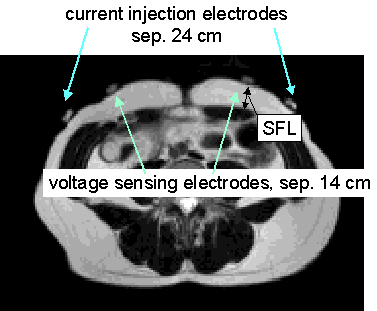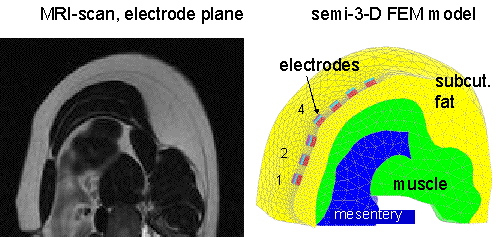FAT AND HYDRATION MONITORING BY
ABDOMINAL IMPEDANCE ANALYSIS:
MODEL-BASED DATA INTERPRETATION
Hermann Scharfetter,
Bernhard
Brandstaetter, Helmut Hinghofer-Szalkay
We investigated the sensitivity of the abdominal
impedance Z measured with four electrodes to fat fractions and hydration
in different abdominal compartments with a finite-element model. The compartments
are subcutaneous fat, muscle, mesentery, spine. Assuming the same percent
change of the fat fraction in all compartments the model predicts a sensitivity
of 1.03 W per mm change of the subcutaneous fat layer thickness (SFL) compared
to 1.1 W/mm measured.
-
60-70 % of the sensitivity stems from the SFL itself,
20-30 % from the mesentery and 10 % from fat in the muscle compartment.
A 1%-increase of the extracellular water in the muscle
is not discernible from a 1% decrease of the SFL. With a fifth electrode
fat fractions and hydration parameters can be identified separately. The
measured Z reflects both SFL and visceral fat.
The hierarchical model could be fitted satisfactorily
to the experimental data yielding parameter values within the expected
range.
-
The observed regression slope of SFL and Z2 (1.1 W/mm)
can be explained by a simultaneous change of the visceral and the subcutaneous
fat fraction. i. e. the method is sensitive to the visceral fat.
-
The hydration of muscle interferes strongly with the
fat parameters. However, it can be clearly discerned whether a weight reduction
is due to fat reduction or dehydration as the trend of the transimpedance
is inverse in both cases.
-
It is impossible to identify hydration and SFL independently
with a 4-terminal arrangement. A better separation of different contributions
can be achieved by adding at least one strategically placed electrode.
The combined evaluation of Z2 and Z4 yields a significant improvement,
Z2 yielding more information about central structures and Z4 characterizing
surface-near compartments. The use of multifrequency data reduces the CV
of the parameters when compared to the single frequency case.
 Transversal
abdominal cross section at the umbilicus
Transversal
abdominal cross section at the umbilicus
 Model structure and electrode numbering (umbilical level)
Model structure and electrode numbering (umbilical level)

Transversal abdominal cross section at the umbilicus
 Model structure and electrode numbering (umbilical level)
Model structure and electrode numbering (umbilical level)